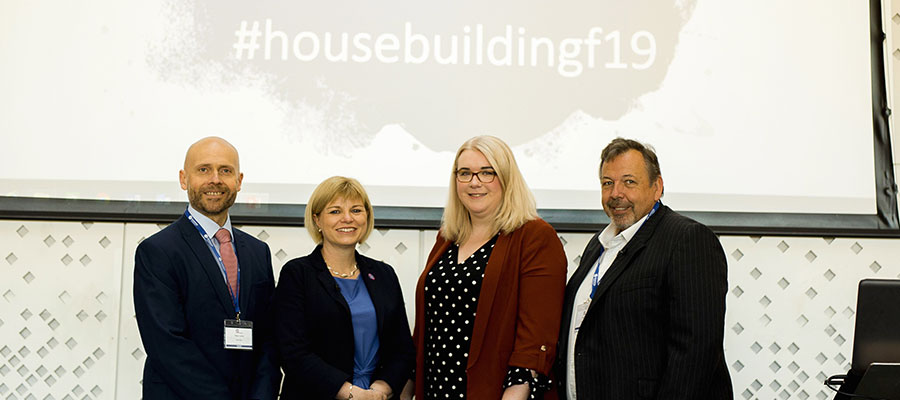Editor Victoria Galligan went along to the annual Housebuilding Forum to meet HAs, builders, architects and suppliers…
The Housebuilding Forum took place at the Slate conference hall in Warwick. As part of the university campus, the striking building – a BREEAM-certified design that boasts floor-to-ceiling windows looking out onto a lake – was the ideal venue to get some of the biggest names in housebuilding together.
As well as hosting expert speakers, the organisers Stable Events line up 15-minute meetings throughout the two-day event to ensure suppliers and delegates can take the time to discuss their work and potential collaborations. The speakers and delegates ranged from across the public and private sectors, and suppliers were on hand to display innovative products and services.

First up on the speaker platform was Stephanie Ainsworth, who is Homes England’s Head of Affordable Housing Deals. Stephanie outlines the strategic partnerships between housing associations and Homes England, which have so far enabled 28 HAs to access £1.74bn in grant funding which will enable more than 39,000 new affordable homes to be started before March 2022. The partnerships are helping to unlock public and private sector land and realise the development potential of sites across England. As well as land, the money is being spent on infrastructure to kickstart developments and will ensure that investment products are available to housebuilders.
A separate grant – the Community Housing Fund – also offers grants totalling £163m to community-led groups who are driving forward the building of affordable housing schemes. The aim is to build 65,000 homes a year in total, with more than half of these being affordable properties and 9,000 of those available for social rent. Around 14,500 will be built in the least affordable areas where people are struggling to find a home. Stephanie said there was the potential for Homes England to push the number of homes built with its support up to 100,000 homes a year – Homes England have already tripled the number of homes HAs were planning to build, thanks to the grant funding.
Stephanie discussed the ambitious engagement strategy and said £2bn was still available through strategic partnerships. And Stephanie said modern methods of construction were being explored to increase productivity and deliver homes quicker. She added: “We welcome partners who share our ambition to challenge traditional norms and build better homes faster.”
Peter Lowe, Relationship Director at Barclays, spoke about its Housing Delivery Fund – £1bn of residential debt funding which was being made available to deliver more housing. Working alongside Homes England, Peter said Barclays wants to “tackle the housing crisis by accelerating the delivery of homes”. The fund is aimed at the SME sector, with the bank working with established firms – although they needn’t be existing customers of Barclays.
He explained that the funding was available in two tiers of interest levels – senior lending at 3%-3.5% and mezzanine lending at 7%-9%. So far, around 10 deals had been struck, worth £300m, and a further 50 sites had been identified as potential borrowers, with another 100 interested in working with Barclays.
Lending can be used to pay for up to 80% of the developments – when senior debt is topped up with junior debt – and there is a specific lending range of £5m to £100m. Peter said the smallest loans were used for developments which equated to around 30 houses.
When asked how long SMEs had to get involved with the scheme, Peter said around seven years – although he said the money was unlikely to run out any time soon!
Val Bagnall of Apex offered a truly inspirational presentation on airspace developments – and it’s not just about adding extra floors to tower blocks.
In 2015, Apex identified 180,000 potential homes which could be built in airspace on London’s blocks – that’s £54billion-worth of property development.
Val explained that Apex was an SME with no track record of business, which made borrowing money from the big banks difficult. But after winning the London Urban Challenge in 2017, the firm was able to secure funding – including £9m in Homes England finance and investment from Business Growth Fund (BGF).
Val highlighted the “wonders of modular and office construction” but also outlined the struggle which MMC suppliers were facing in terms of cashflow, and the need for innovative businesses to receive more support. He said when developers find the right relationship with suppliers, there was then a sharing of risk and the challenge was how to get different business models to work for SMEs.
In terms of affordable housing, Val said 50% of the airspace developments would be affordable – which is a big ask for properties in London. The brand-new penthouse apartments are obviously appealing to tenants and Val said housing associations could offer the new properties to their existing tenants – literally helping them to move up in the world.
The practicalities of airspace building are intriguing – units built offsite are placed on the building, after the roof has been taken off, and this only takes 24 hours. The utility connections, cladding etc which follows takes around two months but the disruption to existing tenants is minimal.
And Val emphasised that airspace development was not just about the top of the building – at one project, the rest of the building was improved as a stairwell and lift were built between two blocks to fuse them into one building. ‘Bookend’ flats at either end of tower blocks can be added. Cladding can be put up around the building to give it a fresh look and existing tenants’ properties can rise in value due to the improvements.
In fact, the financial benefits to housing associations and tenants are quite remarkable – rather than charge your tenants for a new roof, says Val, why not build more units and feed back some of the profits to them in the form of reduced service charges?
The units come with the same warranties as a new build, NHBC or equivalent, and are built to the same spec.
Victoria Hills, Chief Executive of the Royal Town Planning Institute, spoke about the positive changes which had been seen in planning recently – with almost 300,000 consents granted in the past year. Victoria said: “Planning applications are washing through the system more than ever before, and they’ve been rising year-on-year for seven years.”
Victoria pointed out that the number of houses being built at the moment (up 78% on 2012/13 figures) has not been as high since the post-war era, when local authorities began delivering large numbers of social housing properties. And a lot of the new dwellings are down to LAs returning to housebuilding – 65% of LAs are now directly involved in housing provision. She did, however, highlight the fact that local plans needed to be in place for LAs to build – which was not the case for a large number. Victoria also discussed the reliance of Section 106 money being used to prop up affordable housing, at the cost of amenities such as doctors surgeries and schools, which therefore was not improving the local community.
Despite this, only around 4,600 homes for social rent were completed in 2018. Victoria also spoke about permitted developments such as office to residential conversions and how these had been criticised by the RTPI in terms of financial implications for local authorities, who cannot collect planning fees or developer contributions to support affordable housing or infrastructure.
Ian Spero of Agile Ageing Alliance and Jonathan Parnes from Regents Affordable – a developer of affordable housing – presented their vision of using MMC to provide more homes in multi-generational developments. The ageing population, coupled with a stigma around downsizing and the reluctance of older people to move into sub-standard accommodation, has driven the concept of using MMC to create high-rise buildings connected by “Garden Bridges” which can also house small shops and cafes to service the tenants and those in surrounding properties.
Working alongside Tata Steel, Agile Ageing Alliance has produced a white paper entitled Neighbourhoods of the Future. The white paper outlines how MMC can create better homes for an ageing population, who will want to move out of their larger properties to become part of the new communities where they can receive support and live in brand new, accessible accommodation.
The government has pledged £4.7bn over four years to strengthen UK science and business, via its Industrial Strategy Challenge Fund. £300m of this will facilitate the development of new technologies to aid people to grow old in their own home. The white paper features expert insight into the future of housing and a breadth of opinions on how traditional bricks and mortar housing may be a thing of the past when it comes to providing affordable housing on a large scale. Ian said the construction process is being taken apart and the “sweet spot for delivery” of MMC is now upon the industry.
Rod Duncan, Design Director at jmarchitects, showed the audience how the O’Shea halls of residence in Edinburgh were designed and built, and the complexities of developing in a World Heritage site. The halls house 1,160 student bedrooms and replaced a derelict building which had stood on the site and blighted the area for some time.
The design incorporates the jagged angles, tall buildings and narrow streets of Edinburgh’s Old Town and at the same time provides green space and outdoor areas on many different levels which connect the blocks. The emphasis here has been connectivity – in terms of both the spaces and of the students. A large communal kitchen allows students the opportunity to socialise with all tenants and an Outreach Centre which provide learning and meeting spaces. Rod said the landscaped podium and outdoor seating areas at O’Shea increase the opportunity for social abrasion.
Passivhaus is the word on every developer’s lips at the moment – and Joel Callow, Technical Director at Qoda Consulting, discussed the difficulty of converting existing properties into zero-carbon producing homes. He illustrated the point by showing charts on the amount of energy needed in a home of standard construction compared to how much energy it could produce using solar panels – and there was a clear gap. Around 14 solar panels would be needed even in a new-build, so the Victorian terraces and converted farm buildings which many people live in are unlikely to achieve zero-carbon – or at least not without a lot of investment into insulation, roofing, and equipment to produce energy. It’s a challenge – but it can be done! Passivhaus closes this gap to make homes fully sustainable. And with government targets of 80% cuts in carbon by 2050, the housebuilding industry must take on board these challenges as they design and refurbish homes.
Sign up to next year’s Housebuilding Forum, organised by Stable Events, at www.housebuildingforum.co.uk, email sue@stable-events.co.uk or call 0208 288 1080.
Photos: Emily Birch
- Log in to post comments













